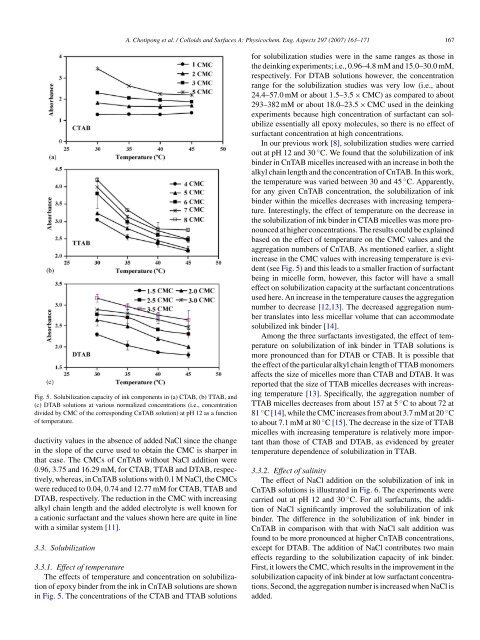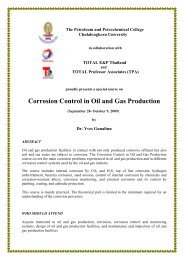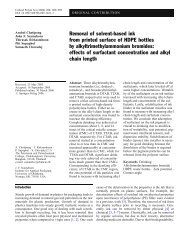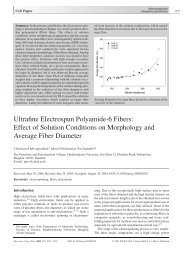Removal of solvent-based ink from printed surface - The Petroleum ...
Removal of solvent-based ink from printed surface - The Petroleum ...
Removal of solvent-based ink from printed surface - The Petroleum ...
You also want an ePaper? Increase the reach of your titles
YUMPU automatically turns print PDFs into web optimized ePapers that Google loves.
A. Chotipong et al. / Colloids and Surfaces A: Physicochem. Eng. Aspects 297 (2007) 163–171 167<br />
Fig. 5. Solubilization capacity <strong>of</strong> <strong>ink</strong> components in (a) CTAB, (b) TTAB, and<br />
(c) DTAB solutions at various normalized concentrations (i.e., concentration<br />
divided by CMC <strong>of</strong> the corresponding CnTAB solution) at pH 12 as a function<br />
<strong>of</strong> temperature.<br />
ductivity values in the absence <strong>of</strong> added NaCl since the change<br />
in the slope <strong>of</strong> the curve used to obtain the CMC is sharper in<br />
that case. <strong>The</strong> CMCs <strong>of</strong> CnTAB without NaCl addition were<br />
0.96, 3.75 and 16.29 mM, for CTAB, TTAB and DTAB, respectively,<br />
whereas, in CnTAB solutions with 0.1 M NaCl, the CMCs<br />
were reduced to 0.04, 0.74 and 12.77 mM for CTAB, TTAB and<br />
DTAB, respectively. <strong>The</strong> reduction in the CMC with increasing<br />
alkyl chain length and the added electrolyte is well known for<br />
a cationic surfactant and the values shown here are quite in line<br />
with a similar system [11].<br />
3.3. Solubilization<br />
3.3.1. Effect <strong>of</strong> temperature<br />
<strong>The</strong> effects <strong>of</strong> temperature and concentration on solubilization<br />
<strong>of</strong> epoxy binder <strong>from</strong> the <strong>ink</strong> in CnTAB solutions are shown<br />
in Fig. 5. <strong>The</strong> concentrations <strong>of</strong> the CTAB and TTAB solutions<br />
for solubilization studies were in the same ranges as those in<br />
the de<strong>ink</strong>ing experiments; i.e., 0.96–4.8 mM and 15.0–30.0 mM,<br />
respectively. For DTAB solutions however, the concentration<br />
range for the solubilization studies was very low (i.e., about<br />
24.4–57.0 mM or about 1.5–3.5 × CMC) as compared to about<br />
293–382 mM or about 18.0–23.5 × CMC used in the de<strong>ink</strong>ing<br />
experiments because high concentration <strong>of</strong> surfactant can solubilize<br />
essentially all epoxy molecules, so there is no effect <strong>of</strong><br />
surfactant concentration at high concentrations.<br />
In our previous work [8], solubilization studies were carried<br />
out at pH 12 and 30 ◦ C. We found that the solubilization <strong>of</strong> <strong>ink</strong><br />
binder in CnTAB micelles increased with an increase in both the<br />
alkyl chain length and the concentration <strong>of</strong> CnTAB. In this work,<br />
the temperature was varied between 30 and 45 ◦ C. Apparently,<br />
for any given CnTAB concentration, the solubilization <strong>of</strong> <strong>ink</strong><br />
binder within the micelles decreases with increasing temperature.<br />
Interestingly, the effect <strong>of</strong> temperature on the decrease in<br />
the solubilization <strong>of</strong> <strong>ink</strong> binder in CTAB micelles was more pronounced<br />
at higher concentrations. <strong>The</strong> results could be explained<br />
<strong>based</strong> on the effect <strong>of</strong> temperature on the CMC values and the<br />
aggregation numbers <strong>of</strong> CnTAB. As mentioned earlier, a slight<br />
increase in the CMC values with increasing temperature is evident<br />
(see Fig. 5) and this leads to a smaller fraction <strong>of</strong> surfactant<br />
being in micelle form, however, this factor will have a small<br />
effect on solubilization capacity at the surfactant concentrations<br />
used here. An increase in the temperature causes the aggregation<br />
number to decrease [12,13]. <strong>The</strong> decreased aggregation number<br />
translates into less micellar volume that can accommodate<br />
solubilized <strong>ink</strong> binder [14].<br />
Among the three surfactants investigated, the effect <strong>of</strong> temperature<br />
on solubilization <strong>of</strong> <strong>ink</strong> binder in TTAB solutions is<br />
more pronounced than for DTAB or CTAB. It is possible that<br />
the effect <strong>of</strong> the particular alkyl chain length <strong>of</strong> TTAB monomers<br />
affects the size <strong>of</strong> micelles more than CTAB and DTAB. It was<br />
reported that the size <strong>of</strong> TTAB micelles decreases with increasing<br />
temperature [13]. Specifically, the aggregation number <strong>of</strong><br />
TTAB micelles decreases <strong>from</strong> about 157 at 5 ◦ C to about 72 at<br />
81 ◦ C [14], while the CMC increases <strong>from</strong> about 3.7 mM at 20 ◦ C<br />
to about 7.1 mM at 80 ◦ C [15]. <strong>The</strong> decrease in the size <strong>of</strong> TTAB<br />
micelles with increasing temperature is relatively more important<br />
than those <strong>of</strong> CTAB and DTAB, as evidenced by greater<br />
temperature dependence <strong>of</strong> solubilization in TTAB.<br />
3.3.2. Effect <strong>of</strong> salinity<br />
<strong>The</strong> effect <strong>of</strong> NaCl addition on the solubilization <strong>of</strong> <strong>ink</strong> in<br />
CnTAB solutions is illustrated in Fig. 6. <strong>The</strong> experiments were<br />
carried out at pH 12 and 30 ◦ C. For all surfactants, the addition<br />
<strong>of</strong> NaCl significantly improved the solubilization <strong>of</strong> <strong>ink</strong><br />
binder. <strong>The</strong> difference in the solubilization <strong>of</strong> <strong>ink</strong> binder in<br />
CnTAB in comparison with that with NaCl salt addition was<br />
found to be more pronounced at higher CnTAB concentrations,<br />
except for DTAB. <strong>The</strong> addition <strong>of</strong> NaCl contributes two main<br />
effects regarding to the solubilization capacity <strong>of</strong> <strong>ink</strong> binder.<br />
First, it lowers the CMC, which results in the improvement in the<br />
solubilization capacity <strong>of</strong> <strong>ink</strong> binder at low surfactant concentrations.<br />
Second, the aggregation number is increased when NaCl is<br />
added.





